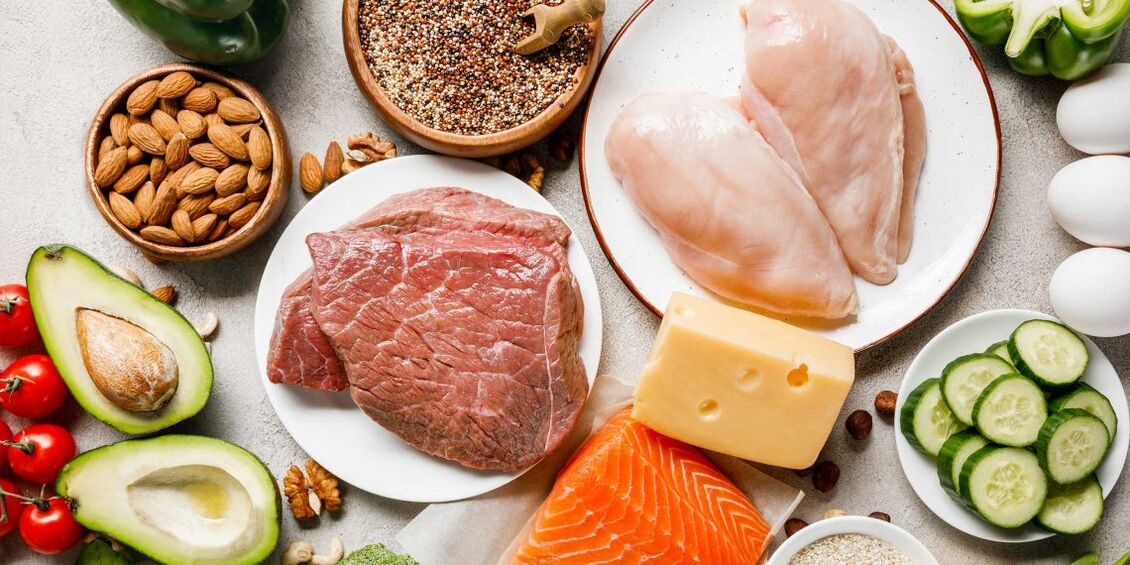On a ketogenic diet you eat a lot of fatty foods and exclude everything flour and sweet. 60–70% of all calories should come from fats, 20-30% of protein and only 10% of carbohydrates. Particular attention is paid to carbohydrates: you can’t eat more than 50 g per day, regardless of your weight and calorie consumption.

Fat can be obtained from vegetable oils and lard, meat and fish, cheese, sour cream, ugly yogurt, eggs, and nuts. Most of these products also contain enough protein to get into the daily rate - 1. 5–2 g per kilogram of body weight. You get carbohydrates only from vegetables, unsweetened fruits and berries to gain enough vitamins. No familiar side dishes: cereals, pasta, potatoes. Absolute ban on sweets and alcohol.
Due to which you lose weight on a keto diet
Carbohydrates are the main fuel of the body. When you consume less than 50 g of carbohydrates per day, their reserves in the body are depleted after a day, and the body begins to split fat and use fatty acids for energy production. However, not all organs can eat fats: the brain simply needs glucose or some replacement.
To get glucose, the liver makes ketone bodies from fatty acids: acetate, which then turns into beta-hydroxybutic and nourishes the brain, heart, kidneys, muscles and other tissues. As an exchange product, acetone is formed, so its concentration in the urine increases, and breathing becomes sweet.
In general, ketones are constantly produced in the body, their concentration in the blood is about 0. 2-0. 5 mmol/l. When their level grows to 0. 5–5 mmol/l, food ketosis occurs. It is not dangerous to health, unlike ketoacidosis, in which the concentration of ketone bodies rises to 10–25 mmol/l. This condition can occur in dying from hunger.
Despite the fact that you do not reduce the calorie content of the diet, in a state of ketosis the body begins to get rid of fat reserves. Since the level of glucose in the blood strives for zero, the production of the hormone insulin is inhibited, and with it lipogenesis is the deposition of fats in reserve. Moreover, Keto Diet reduces your appetite, which also helps you to lose weight: you do not consider calories and do not break.
How much can be thrown on a ketogenic diet
Everything is individual here. In a review of six studies dedicated to a ketogenic diet, participants lost from 3. 2 to 12 kg in six months. If we take the average value for all results in the review, it will turn out about 6 kg in 6 months.
Who should try a keto diet
Despite the complexity of the first days and strict restrictions, the ketogenic diet is perfect for some people. It is worth trying it:
- Those who love meat. If you cannot live without it and fatty products, and your diet is indifferent to sweets and bread, your option.
- Those who want to lose weight without losing muscle mass. Keto diet helps to throw off fat, including visceral, and at the same time preserve dry muscle mass. Moreover, the diet does not affect power indicators, so that it is quite suitable for athletes of power sports. Although it will not work to increase the muscles.
- People with diabetes of the 1st and 2nd type. Due to the failures in the production of insulin, diabetics are forced to take this hormone in order to avoid sharp jumps in blood sugar. Keto diet greatly reduces its level. But before moving to Keto, a diet must be consulted with the attending physician.
- Those who want to maintain brain health. Keto diet has a positive effect on mental and emotional health, protects the brain from neurodegenerative diseases, and helps with migraine and epilepsy.
- Those who want to reduce the risk of atherosclerosis. Diet reduces the amount of "bad" cholesterol and fats in the blood and increases the percentage of "good".
- Those who are afraid of Cancer Keto Diet limit the reactive forms of oxygen and reduces inflammation, which is often associated with the occurrence of oncology.
- Runners and athletes. If you are an athlete of a cyclic sport for endurance, Keto diet can improve your indicators.

Who can't sit on a ketogenic diet
This diet is contraindicated:
- People with kidney and liver diseases, oxidation of fatty acids.
- Those who are engaged in team sports, athletes, runners at medium distances. If classes involve a long stay in anaerobic mode, Keto Diet will reduce your indicators.
- People with fragile bones. Possible side effects of the diet include changes in the mineral composition of bones, which can lead to an increase in the risk of fractures.
Is it difficult to adhere to a ketogenic diet
Keto Diet is not the lightest diet, especially at first. When your body begins to experience glucose, the symptoms of Keto -Gripp can manifest: nausea, vomiting, headaches, fatigue, dizziness, insomnia of constipation. They last from 2-3 days to several weeks. In this case, you can not consume more carbohydrates to alleviate the condition.
If you break, the body will receive the desired glucose, you will come out of ketosis and have to repeat it all over again. This is the difficulty of maintaining a diet. On the other hand, this is its advantage: you know that after the breakdown you will again have to go through unpleasant adaptation, so you will hold on.
How to sit on a keto a genetic diet
A personal coach and nutritionist propose to divide the period of entry into a diet into several phases and adhere to certain rules.
1. Preliminary preparation (2-4 weeks)
Enter 40–80 g of coconut oil into the diet to provide the body with triglycerides. They are quickly absorbed, not deposited in fat and processed in the liver in ketone bodies. Instead of oil, you can consume a food supplement with ketones in the form of powder.
Reduce the amount of carbohydrates to 100 g per day. So you will not go into ketosis, but teach yourself there is less food rich in carbohydrates.
2. Entering ketosis (4 days)
Day 1. Skip breakfast and lunch, starve all day until the evening. In dinner, there should be no more than 200-300 kcal, 10-15 g of protein and 15-30 g of fat. No carbohydrates.
Day 2. Eat the same portion for breakfast and for lunch, for dinner - ⅔ from your usual portion of food. No carbohydrates.
Day 3. For breakfast and lunch, you can eat ⅔ from a regular portion of food, make dinner full. There are still no carbohydrates.
Day 4. Eat your usual portions, you can turn on the necracerate vegetables and unsweetened fruits.
During this phase of training, it is better to replace with long walks. This will burn glucose and help to enter ketosis faster. If on a walk it seems to you that forces are over at the legs, this is a good sign: glycogen reserves are almost exhausted.
Continue to take coconut oil or carbohydrate powder, add vitamins and a drink with electrolytes.
3. Keto Adaptation (2-4 weeks)
You will need several weeks to fully adapt to the diet. At this time, you need to support carbohydrates within 30 g per day - if you are engaged, and 20 g - if not. Keep in mind that at first the energy level will be slightly lower. This is normal and gradually pass. At this stage, it is no longer necessary to take carbohydrate powder.

How much to sit on a keto diet and how to go out so that the weight does not return
Keto Genetic diet can last from 3-4 weeks to a year. It makes no sense to adhere to a diet for less than three weeks, because during this time your body will pass adaptation through Keto and you will only begin to get all the advantages of this diet. As for the terms of more than a year, there is not enough scientific data to judge this, but eating like this all your life is a bad idea. Firstly, a prolonged keto diet increases the risk of liver obesity, hypoproteinemia, kidneys and deficiency of vitamins and minerals. Secondly, the abandonment of one of the macro elements does not affect the life of life in the best way. An analysis of the data of more than 15 thousand people showed that both excess and lack of carbohydrates in the long run increase the risk of death. The longest lived people whose diet consisted of carbohydrates by 50–55%.
Good news: it will not be so difficult to hold the weight after a diet of a diet.
With a conventional diet with a cut calorie content, the amount of ghrelin-hunger hormone increases, because of which a person wants to eat all the time, breaks down and after completion throws up for food. The study showed that with ketogenic such changes does not occur, so it would be easier for you to hold weight. Another study testified that 40 days of a diet with a half -year break for the Mediterranean diet led to a stable weight loss without further set.
The Mediterranean diet is a great option after Keto. It also contains a lot of fats that you will get used to, and carbohydrates are consumed from useful sources: whole grain products, vegetables and fruits. Unlike Keto diet, Mediterranean can be maintained all your life without health risks.















